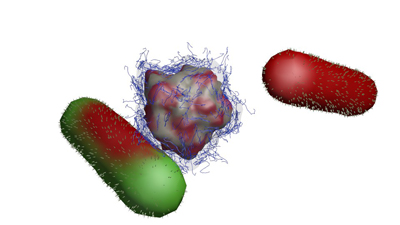Environmentally Friendly Lignin Nanoparticle ‘Greens’ Silver Nanobullet to Battle Bacteria

For Immediate Release
North Carolina State University researchers have developed an effective and environmentally benign method to combat bacteria by engineering nanoscale particles that add the antimicrobial potency of silver to a core of lignin, a ubiquitous substance found in all plant cells. The findings introduce ideas for better, greener and safer nanotechnology and could lead to enhanced efficiency of antimicrobial products used in agriculture and personal care.
In a study published in Nature Nanotechnology, NC State engineer Orlin Velev and colleagues show that silver-ion infused lignin nanoparticles, which are coated with a charged polymer layer that helps them adhere to the target microbes, effectively kill a broad swath of bacteria, including E. coli and other harmful microorganisms.

As the nanoparticles wipe out the targeted bacteria, they become depleted of silver. The remaining particles degrade easily after disposal because of their biocompatible lignin core, limiting the risk to the environment.
“People have been interested in using silver nanoparticles for antimicrobial purposes, but there are lingering concerns about their environmental impact due to the long-term effects of the used metal nanoparticles released in the environment,” said Velev, INVISTA Professor of Chemical and Biomolecular Engineering at NC State and the paper’s corresponding author. “We show here an inexpensive and environmentally responsible method to make effective antimicrobials with biomaterial cores.”
The researchers used the nanoparticles to attack E. coli, a bacterium that causes food poisoning; Pseudomonas aeruginosa, a common disease-causing bacterium; Ralstonia, a genus of bacteria containing numerous soil-borne pathogen species; and Staphylococcus epidermis, a bacterium that can cause harmful biofilms on plastics – like catheters – in the human body. The nanoparticles were effective against all the bacteria.
The method allows researchers the flexibility to change the nanoparticle recipe in order to target specific microbes. Alexander Richter, the paper’s first author and an NC State Ph.D. candidate who won a 2015 Lemelson-MIT Student Prize, says that the particles could be the basis for reduced risk pesticide products with reduced cost and minimized environmental impact.
“We expect this method to have a broad impact,” Richter said. “We may include less of the antimicrobial ingredient without losing effectiveness while at the same time using an inexpensive technique that has a lower environmental burden. We are now working to scale up the process to synthesize the particles under continuous flow conditions.”
Funding was provided by the U.S. Environmental Protection Agency, the National Science Foundation and NC State. Researchers from the EPA, University of Hull, Wageningen University and University College London participated in the study.
– kulikowski –
Note to editors: An abstract of the paper follows.
“An environmentally benign antimicrobial nanoparticle based on a silver-infused lignin core”
Authors: Alexander P. Richter, Joseph S. Brown, Bhuvensh Bharti and Orlin D. Velev, North Carolina State University; Amy Wang, Sumit Gangwal, Keith Houck and Elaine A. Cohen Hubal, U.S. EPA; Vesselin N. Paunov, University of Hull; and Simeon D. Stoyanov, Wageningen University and University College London
Published: July 13, 2015, online in Nature Nanotechnology
DOI: 10.1038/nnano.2015.141
Abstract: Silver nanoparticles have antibacterial properties, but their use has been a cause for concern because they persist in the environment. Here, we show that lignin nanoparticles infused with silver ions and coated with a cationic polyelectrolyte layer form a biodegradable and green alternative to silver nanoparticles. The polyelectrolyte layer promotes the adhesion of the particles to bacterial cell membranes and, together with silver ions, can kill a broad spectrum of bacteria, including Escherichia coli, Pseudomonas aeruginosa and quaternary-amine-resistant Ralstonia sp. Ion depletion studies have shown that the bioactivity of these nanoparticles is time-limited because of the desorption of silver ions. High-throughput bioactivity screening did not reveal increased toxicity of the particles when compared to an equivalent mass of metallic silver nanoparticles or silver nitrate solution. Our results demonstrate that the application of green chemistry principles may allow the synthesis of nanoparticles with biodegradable cores that have higher antimicrobial activity and smaller environmental impact than metallic silver nanoparticles.
- Categories:


